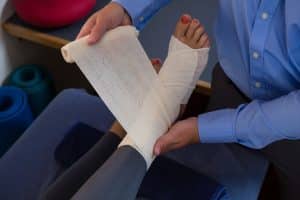There’s no place quite like Flagstaff for outdoor adventures, from running the Urban Trail System to scoring big at local rec league games. Unfortunately, active lifestyles sometimes lead to injuries, with Jones fractures being a common but tricky problem for many. Northern Arizona Orthopaedics (NAO) is here to demystify this unique injury and share how their Flagstaff team helps locals recover and stay active.
What Is a Jones Fracture? 
A Jones fracture is a break near the base of the fifth metatarsal, the long bone on the outside of your foot, just before your pinky toe. Unlike simple stress fractures, this area of the foot doesn’t get much blood flow, which makes healing more challenging and often requires expert orthopedic attention.
How Do Jones Fractures Happen in Flagstaff?
Flagstaff’s rugged trails, basketball courts, and even icy winter sidewalks can contribute to Jones fractures. These injuries happen when you twist your foot inwards (like rolling an ankle), land awkwardly, or put repeated stress on your foot during sports. Trail runners, hikers on rocky ground, and athletes in jumping sports (like basketball) are especially at risk.
Symptoms to Watch For:
- Sharp pain on the outside of the midfoot
- Swelling and possible bruising near the pinky toe
- Trouble walking or putting weight on the foot
- Pain that doesn’t improve with rest
Jones Fracture Risk by Activity in Flagstaff
| Activity | Jones Fracture Risk | Notes |
| Trail running | High | Uneven terrain common in Flagstaff |
| Basketball | High | Lateral movement & jumping |
| Hiking | Moderate-High | Riskier on technical trails |
| City walking | Low-Moderate | Higher with ice in winter |
| Swimming/Yoga | Low | Foot rarely exposed to trauma |
Diagnoses and Treatment at NAO
At NAO, Jones fractures are diagnosed through on-site X-rays for immediate imaging, along with a comprehensive physical exam and medical history. In more complex or subtle cases, advanced diagnostic tools may also be used to ensure an accurate diagnosis.
Treatment for Jones fractures typically begins with immobilization using a cast, boot, or crutches to allow the bone to heal, along with limiting or preventing weight-bearing activities in the early stages. Once healing progresses, physical therapy helps restore strength and balance. In more severe cases, or if the bone fails to heal on its own, which is common among active adults and athletes, surgery may be necessary. While the average healing time is six to eight weeks, it’s essential to follow your orthopedic specialist’s guidance and avoid rushing the recovery process.
Living Active, Staying Safe
- Wear properly fitted trail shoes or athletic sneakers
- Warm up, especially in cold Flagstaff mornings
- Switch up training with lower-impact activities (like swimming at the Aquaplex or yoga)
- Don’t play through foot pain – seek care early
Finding Care at NAO
If you’re struggling with foot pain, think you might have a Jones fracture, or need advice after an injury, get expert help at Northern Arizona Orthopaedics. Call 928-226-2900, visit Urgent Ortho at 1840 N Jasper Dr, or request an appointment at northazortho.com. NAO’s team will help you recover and keep living the Flagstaff lifestyle you love.
- Understanding Hip Labral Tears: Symptoms, Causes, and Treatment Options - December 3, 2025
- Kneecap Bursitis: Symptoms, Treatments, and Recovery in Flagstaff - October 23, 2025
- Jones Fractures: What Flagstaff Locals Should Know - September 30, 2025

